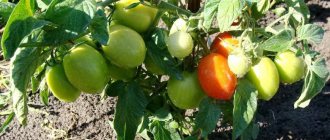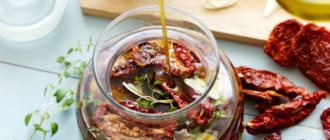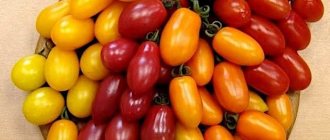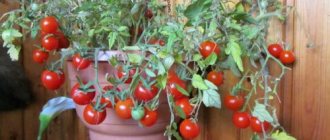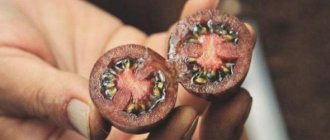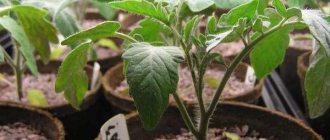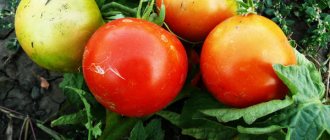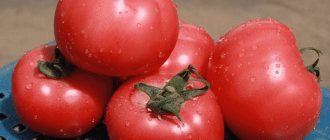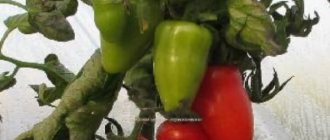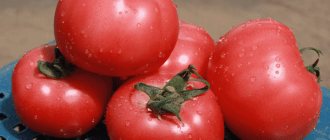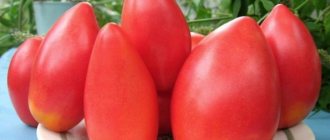Description of the Verige tomato variety, features of cultivation and care
To get an excellent tomato harvest, it is not necessary to have a greenhouse or hotbed. There are many varieties for growing in open beds. Among them is the Verige tomato. It is distinguished by its friendly yield of fruits and early ripeness.
Characteristics of the bush
The bush is determinate, early ripening - 90–95 days pass from planting seeds to receiving the first fruits, while the height of the bush varies from 50 centimeters to 1 meter depending on growing conditions. In open areas the bush does not grow higher than 50 centimeters, but in a greenhouse it grows up to a meter. When growing, it does not require stepsons, but if the weather is bad and the fruits may not have time to ripen, then one or two stepsons are broken off for better growth and ripening of the remaining tomatoes.
The plant is powerful, differs from other varieties in the carpal formation of ovaries and friendly yield. The bushes are resistant to the following diseases - verticillium wilt, tomato mosaic virus, root-knot nematodes and fusarium. Productivity is 5–6 kilograms per square meter.
The fruits are small - cherry, from 10 to 12 fruits are formed on one cluster. The first shoot with tomatoes is formed above the 6th leaf.
Description of fruits
Tomatoes have positive characteristics - they are small, the weight of one tomato reaches 20–25 grams. The red color and regular round shape of tomatoes allow the fruit to be used universally. When cut, it has two replaceable bags with small seeds. The taste is sweet; garden-grown fruits have a slight sour taste, which only improves the taste of the fruit. When ripe, there is no green spot near the stalk.
Since the fruits are resistant to cracking and have excellent commercial quality, this variety is used for the production of vegetable products on an industrial scale.
Agricultural technology for growing Verige
Judging by the description, Verige f1 tomatoes can be grown in open beds and in closed film or polycarbonate greenhouses.
Month-old seedlings are planted in open ground when the average daytime air temperature reaches 23–25 degrees; nighttime temperatures should not fall below 16 degrees. The planting scheme is chosen individually, but the distance between seedlings is left at 60 by 40 centimeters.
Seedlings are planted in protected soil a little earlier - in early or mid-May, depending on weather conditions in the region. After planting, plants need daily care:
- watering;
- loosening;
- garter;
- weeding;
- harvesting.
The variety is determinate, that is, at a certain point in growth it stops forming ovaries, so there is no need to pincher such tomatoes. You just need to tie the bushes to a support so that the bush does not fall to the ground under the weight of the fruit. The remaining manipulations are carried out as when caring for other varieties of tomatoes.
During cultivation, it is necessary to fertilize the soil and green mass with organic and mineral fertilizers. Then the shape and taste of the tomatoes become even better.
Feedback from gardeners about the Verige variety
Thanks to its neat bush and tomato shape, the variety has received numerous reviews from satisfied gardeners.
Tatyana: “Last year I decided to plant small tomatoes, because large ones did not fit into pickling jars. The bushes grew in an open garden bed and produced an excellent harvest. The bush not only bears fruit abundantly, but also performs a decorative function. It is simply hung with beautiful tassels with small tomatoes. Now I recommend this variety to everyone I know.”
Growing seedlings
Seeds are planted for seedlings in the second half of March. First you need to prepare the seeds for planting. To do this, perform the following steps:
- The planting material is soaked in a weak solution of manganese for 30 minutes, after which the seeds are laid out on a clean sheet of paper and left on the windowsill until completely dry. Manganese allows the seeds to be further protected from fungi and some diseases.
- A growth stimulator solution will speed up the germination process of tomatoes. The seeds are soaked in it for half an hour. Then dry naturally.
Sowing of seeds is carried out in a special container with soil. The soil can be purchased ready-made in the store or you can prepare it yourself. To do this, mix turf soil, peat and sand in equal parts. The soil is well moistened and fluffed up. The seeds are buried 1-1.5 cm into the soil and covered with earth on top.
Watering should be done as needed; it is important to avoid stagnation of moisture and dampness in the container. The greenhouse is covered with film on top and placed in a warm and well-lit place. The film must be removed from the box every day. This is necessary so that the soil is ventilated and excess moisture evaporates.
As soon as the first 2 leaves appear on the sprouts, begin picking. You can plant seedlings in larger containers or use plastic or peat cups for this.
See also
Description of tomato Rosaliza f1 and features of growing a hybrid variety
Read
Gardeners recommend hardening off seedlings before planting in open ground. To do this, you need to take the box with young shoots outside for 1-1.5 hours every day. This can be done if the temperature outside is above zero.
Description of fruits
Tomatoes have positive characteristics - they are small, the weight of one tomato reaches 20–25 grams. The red color and regular round shape of tomatoes allow the fruit to be used universally. When cut, it has two replaceable bags with small seeds. The taste is sweet; garden-grown fruits have a slight sour taste, which only improves the taste of the fruit. When ripe, there is no green spot near the stalk.
Since the fruits are resistant to cracking and have excellent commercial quality, this variety is used for the production of vegetable products on an industrial scale.
Tomato Verige F1: variety description
Various varieties of cherry tomatoes are very popular among vegetable growers. The Verige F1 tomato has good reviews; the description and height of the bush, its characteristics and care features are indicated on the package with the seeds.
The manufacturer indicates that this nightshade hybrid is an unpretentious and hardy variety, and also has good immunity to disease. Even a novice gardener can grow miniature, tasty tomatoes. But before you start growing, it’s still worth studying the features of the Verige variety and recommendations for its cultivation.
Main characteristics
Tomato variety Verige F1 belongs to the determinate species. The plant has a small and compact appearance. It reaches a height of no more than 1 m. The strong and powerful trunk does not need additional support; its branches are not spreading, slightly directed upwards. The foliage has a regular shape and is dark green in color. It sparsely fills the entire plant.
The Verige variety belongs to the early ripening species. The first fruits can be harvested 85-90 days after the first sprouting of seedlings. The tomato is suitable for growing in open ground and in greenhouse conditions.
The first ovary of the raceme is formed after 6-7 leaves. On average there are from 8 to 12 tomatoes on one brush. The small fruits have a round and slightly elongated shape, are bright red in color, and two-chambered. The average weight of one tomato is about 20-25 g. The peel of tomatoes is dense, smooth and shiny. Thanks to its properties, the fruits are protected from cracking.
The shelf life of the crop is quite long: from 2 to 4 weeks. The yield of the Verige variety is high; from 1 m² you can harvest from 5 to 7 kg. Hard and dense cherry tomato fruits withstand long-term transportation.
The taste of these tomatoes is excellent. They have juicy and dense pulp, a pronounced tomato taste with a slight sourness. Verige tomatoes have a sugary flavor with fruity notes. The fruits are suitable for universal use. You can use them to make fresh salads, juice, pasta and canned whole.
The Verige tomato variety tolerates drought and heat well. Its dense peel reliably protects the fruit from sunlight, and its powerful root system fully nourishes the bush.
Growing seedlings
Seeds are planted for seedlings in the second half of March. First you need to prepare the seeds for planting. To do this, perform the following steps:
- The planting material is soaked in a weak solution of manganese for 30 minutes, after which the seeds are laid out on a clean sheet of paper and left on the windowsill until completely dry. Manganese allows the seeds to be further protected from fungi and some diseases.
- A growth stimulator solution will speed up the germination process of tomatoes. The seeds are soaked in it for half an hour. Then dry naturally.
Sowing of seeds is carried out in a special container with soil. The soil can be purchased ready-made in the store or you can prepare it yourself. To do this, mix turf soil, peat and sand in equal parts. The soil is well moistened and fluffed up. The seeds are buried 1-1.5 cm into the soil and covered with earth on top.
Watering should be done as needed; it is important to avoid stagnation of moisture and dampness in the container. The greenhouse is covered with film on top and placed in a warm and well-lit place.
The film must be removed from the box every day. This is necessary so that the soil is ventilated and excess moisture evaporates.
As soon as the first 2 leaves appear on the sprouts, begin picking. You can plant seedlings in larger containers or use plastic or peat cups for this.
Gardeners recommend hardening off seedlings before planting in open ground. To do this, you need to take the box with young shoots outside for 1-1.5 hours every day. This can be done if the temperature outside is above zero.
Planting tomatoes
Planting material is planted in open ground when the risk of night frosts is excluded and the temperature does not drop below 10°C.
Before planting, the beds are dug up and fertilizers are added to the soil. The scheme for planting seedlings is 70 by 40, 6-7 plants per 1 m².
After planting, the holes must be mulched with sawdust and watered well with settled water. After some time, it is worth fertilizing with complex fertilizer.
Main characteristics
Tomato variety Verige F1 belongs to the determinate species. The plant has a small and compact appearance. It reaches a height of no more than 1 m. The strong and powerful trunk does not need additional support; its branches are not spreading, slightly directed upwards. The foliage has a regular shape and is dark green in color. It sparsely fills the entire plant.
The Verige variety belongs to the early ripening species. The first fruits can be harvested 85-90 days after the first sprouting of seedlings. The tomato is suitable for growing in open ground and in greenhouse conditions.
The first ovary of the raceme is formed after 6-7 leaves. On average there are from 8 to 12 tomatoes on one brush. The small fruits have a round and slightly elongated shape, are bright red in color, and two-chambered. The average weight of one tomato is about 20-25 g. The peel of tomatoes is dense, smooth and shiny. Thanks to its properties, the fruits are protected from cracking.
Tomatoes ripen on bunches at the same time, which greatly simplifies the harvesting process. Sometimes gardeners prefer to harvest by picking the whole cluster at once. In this form, Verige tomatoes can be stored for a long time. The shelf life of the crop is quite long: from 2 to 4 weeks. The yield of the Verige variety is high; from 1 m² you can harvest from 5 to 7 kg. Hard and dense cherry tomato fruits withstand long-term transportation.
See also
Characteristics and description of Padishah tomato and other exclusive varieties
Read
The taste of these tomatoes is excellent. They have juicy and dense pulp, a pronounced tomato taste with a slight sourness. Verige tomatoes have a sugary flavor with fruity notes. The fruits are suitable for universal use. You can use them to make fresh salads, juice, pasta and canned whole.
The Verige tomato variety tolerates drought and heat well. Its dense peel reliably protects the fruit from sunlight, and its powerful root system fully nourishes the bush.
Tomato Pablo: variety description, yield and cultivation with photos
Tomato lovers will appreciate the fruit of modern selection - the Pablo f1 tomato. Numerous advantages have ensured that the variety is in demand among gardeners in different regions of Russia. The originator of the plant was the Japanese company Sakata, and today the new product was officially entered into the state register.
General information about tomato
The Pablo variety of tomato is suitable for growing in greenhouses and open beds. Description of the appearance and characteristics of the plant:
- early ripening, the period before harvest is 95 days;
- indeterminate, has unlimited growth;
- tall, reaches 2 meters;
- powerful root system;
- good foliage;
- slightly ribbed;
- average yield, over the summer they get up to 4 kg per 1 sq. meters of landing;
- the number of fruits in the cluster is 5-6 pieces;
- good adaptive abilities;
- ease of care;
- resistance to most diseases of the nightshade family;
- possibility of transportation over long distances without loss of presentation;
- keeping quality.
Tomatoes have become a novelty among hybrid varieties. The ability to bear fruit in unfavorable weather conditions and poor soils has made it possible to grow tomatoes in all regions of Russia. Technical data and appearance of the fruit:
- flat-round, leveled shape;
- dense;
- thin skin;
- large, average weight 200 grams;
- red color when ripe;
- sweet taste;
- fleshy, not watery;
- fragrant.
Recommendations for cultivation
The plant prefers the seedling method of planting. Preparatory work begins 2 months before the expected planting date. When preparing seedlings, it is recommended:
- sow seeds to a depth of 1-1.5 cm;
- after planting, cover the containers with film;
- maintain temperature 21-25 degrees;
- after the sprouts appear, remove the film, transplant the tomatoes into separate pots and move them to the light;
- regular watering;
- picking.
IMPORTANT! Before planting, seedlings should be hardened
For 1 sq. Place no more than four tomatoes per meter of land according to a 40 x 60 cm pattern. The plant is undemanding; mandatory care measures include:
- watering with water not lower than the air temperature;
- feeding with complex mineral fertilizer, at least 4 times during the summer period;
- regular loosening and weeding of the soil;
- pinching, forming a bush into one stem;
- installation of supports and tying to the trellis with synthetic materials.
Gardeners' opinion
Good afternoon. I've heard positive reviews about Pablo's tomato. This summer I tried to grow it and was pleased.
The tomato bore fruit in the cold summer, withstood all unfavorable conditions, and had good yields. Suitable for cultivation in the northern regions of Russia. There were no difficulties in care. In greenhouse conditions I received 3 kilograms of berries from 1 sq. meters of landing. I recommend!
Valerian Egorovich, 54 years old.
Good afternoon! I recommend the Pablo variety to all tomato lovers. It tolerates heat well and does not require close attention. Suitable for growing in open ground in the southern regions of Russia. Ripe berries are suitable for salads, twists and pickles.
Agricultural technology for growing Verige
Judging by the description, Verige f1 tomatoes can be grown in open beds and in closed film or polycarbonate greenhouses.
Month-old seedlings are planted in open ground when the average daytime air temperature reaches 23–25 degrees; nighttime temperatures should not fall below 16 degrees. The planting scheme is chosen individually, but the distance between seedlings is left at 60 by 40 centimeters.
Seedlings are planted in protected soil a little earlier - in early or mid-May, depending on weather conditions in the region. After planting, plants need daily care:
- watering;
- loosening;
- garter;
- weeding;
- harvesting.
The variety is determinate, that is, at a certain point in growth it stops forming ovaries, so there is no need to pincher such tomatoes. You just need to tie the bushes to a support so that the bush does not fall to the ground under the weight of the fruit. The remaining manipulations are carried out as when caring for other varieties of tomatoes.
During cultivation, it is necessary to fertilize the soil and green mass with organic and mineral fertilizers. Then the shape and taste of the tomatoes become even better.
Watering and mulching
When watering a tomato, it is necessary to direct the stream of water directly under the root of the plant, while the leaves must remain dry. An overhead sprinkler is not suitable for watering tomatoes; plants can get sick by picking up spores of pathogenic microorganisms on wet leaves. The soil should not be allowed to dry out; regular watering should be established, without water stagnation.
In areas with high temperatures, you may need to mulch around the base of the plant to keep the roots from drying out and also to help with moisture retention. Mulching is fine and if you live in cold areas, it can protect the plant from hypothermia.
Achieve optimal moisture ratios for planted tomatoes. Use warm or room temperature water for irrigation; it is better to water early in the morning or in the evening every two to three days.
Care
After watering during transplantation, take a week's break to allow the root system to take root safely. Then moisturize as needed - not too often, but generously. Watering is especially important during flowering and fruit ripening.
In a greenhouse, you can water once a week or once a week, depending on the weather. The soil should be kept moderately moist and under no circumstances should it dry out. But the tomato will not react in the best way to overwatering.
In greenhouse conditions, the ideal irrigation method is drip.
After watering, be sure to loosen the row spacing. You should also keep the soil clean.
The Blagovest tomato will have to be fed regularly. To do this, every 15–20 days you can use complex fertilizers for vegetable crops or special formulations for tomatoes. Tomato especially needs superphosphate and potassium supplements. 2 weeks before the mass harvest, feeding is stopped.
Be sure to carry out preventive inspection and treatment of plants against diseases and pests. Pay close attention to leaf curl - this sign may indicate the onset of a disease or the appearance of pests.
Although a greenhouse is considered an ideal place for growing tomatoes, disease and pest prevention must be carried out
Formation
Tomato Blagovest, given its tall growth, definitely needs a garter. To do this, you need to build vertical trellises in the greenhouse. First, the strong seedlings are tied up at the base, and then the growing trunk is sent up along a strong rope.
It is recommended to form the variety into one stem. But the peculiarity of blagovest is an interesting way of self-regulation of growth. Having reached a height of 1.5, sometimes 2 m, the plant forms an inflorescence at the top, at which growth stops. If the height of the greenhouse allows the plant to be grown further, then a new top is formed from the strongest upper stepson.
Another method of formation is allowed - two-stem. To create a second stem, select a developed stepson located just above the first flower raceme. Sometimes the second stem is formed from a shoot located below the first brush. This can also be done, but in this case the tomato fruits will ripen a little later, since the new trunk will take nutrients from them.
There are 2 methods of formation suitable for the Blagovest tomato - one and two stems
Description of the tomato variety Vernissage, features of cultivation and care
The Vernissage yellow tomato is valued not only for the original color of the fruit, but also for the fact that it contains a small percentage of purines, which cause allergies in many people. The variety was bred by Ruslan Dukhov, who lives and crosses different cultures in the village of Mishurin Rog, which is located in the outback of the Dnepropetrovsk region.
Line of tomatoes
The breeder created a whole series of Vernissage tomatoes. In 2012, Ruslan received an award for the black fruit with yellow stripes. The tomato was highly praised for its taste.
The pink variety of Perfume was created by crossing Chinese velvet with Moravian miracle. The bush reaches a height of up to one and a half meters. The fruits are set in clusters, each of 6 tomatoes weighs from 60 to 85 g.
Tomatoes are canned for the winter. Vernissage pink surprises with its yield. One plant produces up to 15 kg of brightly colored fruits with yellow stripes.
Features of the variety
All Vernissage series tomatoes have beautiful fruits of different colors. The indeterminate plant is grown in fields and summer cottages in Moldova, Ukraine, and the southern regions of Russia. The variety feels fine in a greenhouse. Tomato bushes stretch to a height of 1.5 m, so their tops are cut off. To prevent them from growing, the shoots are removed, leaving not all the stems, but only two or three of them, which are tied to the trellis.
The first yellow tomato with pink streaks ripens 2 months after the growing season and has:
- rounded shape;
- pink stripes;
- thick skin;
- sweet taste;
- pleasant sourness.
1 bunch produces 6 fruits; no more than 4 bushes are planted per square meter. An average of 14 kg of tomatoes is harvested from such an area. To make them larger, leave 8 brushes.
Description of tomato Verige F1, growing seedlings of a hybrid variety
Various varieties of cherry tomatoes are very popular among vegetable growers. The Verige F1 tomato has good reviews; the description and height of the bush, its characteristics and care features are indicated on the package with the seeds.
The manufacturer indicates that this nightshade hybrid is an unpretentious and hardy variety, and also has good immunity to disease. Even a novice gardener can grow miniature, tasty tomatoes. But before you start growing, it’s still worth studying the features of the Verige variety and recommendations for its cultivation.
Main characteristics
Tomato variety Verige F1 belongs to the determinate species. The plant has a small and compact appearance. It reaches a height of no more than 1 m. The strong and powerful trunk does not need additional support; its branches are not spreading, slightly directed upwards. The foliage has a regular shape and is dark green in color. It sparsely fills the entire plant.
The Verige variety belongs to the early ripening species. The first fruits can be harvested 85-90 days after the first sprouting of seedlings. The tomato is suitable for growing in open ground and in greenhouse conditions.
The first ovary of the raceme is formed after 6-7 leaves. On average there are from 8 to 12 tomatoes on one brush. The small fruits have a round and slightly elongated shape, are bright red in color, and two-chambered. The average weight of one tomato is about 20-25 g. The peel of tomatoes is dense, smooth and shiny. Thanks to its properties, the fruits are protected from cracking.
Tomatoes ripen on bunches at the same time, which greatly simplifies the harvesting process. Sometimes gardeners prefer to harvest by picking the whole cluster at once. In this form, Verige tomatoes can be stored for a long time. The shelf life of the crop is quite long: from 2 to 4 weeks. The yield of the Verige variety is high; from 1 m² you can harvest from 5 to 7 kg. Hard and dense cherry tomato fruits withstand long-term transportation.
The taste of these tomatoes is excellent. They have juicy and dense pulp, a pronounced tomato taste with a slight sourness. Verige tomatoes have a sugary flavor with fruity notes. The fruits are suitable for universal use. You can use them to make fresh salads, juice, pasta and canned whole.
The Verige tomato variety tolerates drought and heat well. Its dense peel reliably protects the fruit from sunlight, and its powerful root system fully nourishes the bush.
Growing seedlings
Seeds are planted for seedlings in the second half of March. First you need to prepare the seeds for planting. To do this, perform the following steps:
- The planting material is soaked in a weak solution of manganese for 30 minutes, after which the seeds are laid out on a clean sheet of paper and left on the windowsill until completely dry. Manganese allows the seeds to be further protected from fungi and some diseases.
- A growth stimulator solution will speed up the germination process of tomatoes. The seeds are soaked in it for half an hour. Then dry naturally.
Sowing of seeds is carried out in a special container with soil. The soil can be purchased ready-made in the store or you can prepare it yourself. To do this, mix turf soil, peat and sand in equal parts. The soil is well moistened and fluffed up. The seeds are buried 1-1.5 cm into the soil and covered with earth on top.
Watering should be done as needed; it is important to avoid stagnation of moisture and dampness in the container. The greenhouse is covered with film on top and placed in a warm and well-lit place. The film must be removed from the box every day. This is necessary so that the soil is ventilated and excess moisture evaporates.
As soon as the first 2 leaves appear on the sprouts, begin picking. You can plant seedlings in larger containers or use plastic or peat cups for this.
Gardeners recommend hardening off seedlings before planting in open ground. To do this, you need to take the box with young shoots outside for 1-1.5 hours every day. This can be done if the temperature outside is above zero.
Planting tomatoes
Planting material is planted in open ground when the risk of night frosts is excluded and the temperature does not drop below 10°C.
Before planting, the beds are dug up and fertilizers are added to the soil. The scheme for planting seedlings is 70 by 40, 6-7 plants per 1 m².
After planting, the holes must be mulched with sawdust and watered well with settled water. After some time, it is worth fertilizing with complex fertilizer.
The characteristics of this variety indicate its good germination, rapid growth and good returns in the form of a rich harvest.
moefermerstvo.ru
The best varieties of tomatoes for 2021: photos and descriptions
When choosing tomatoes for their plot, gardeners, first of all, rely on varietal or hybrid characteristics. Productivity is the most important criterion on which the quantity and quality of the harvest depends. Sometimes it can be difficult to choose the right option from the rich variety of tomatoes for open ground and greenhouses. Then varieties are selected depending on the growing region, ripening period, degree of disease resistance and other factors.
Varieties for open ground
A huge number of species with excellent yields are intended for growing vegetables in the open air. Low-growing bushes with large fruits are one of the advantages of tomatoes for the soil. Such heat-loving plants are easier to care for and do not require complex agricultural practices.
According to ripening period
Tomatoes, like other vegetable crops, are characterized by different ripening periods, from early to late.
| Ripening period | Ripening of fruits after the appearance of the first shoots | general characteristics | The most productive tomatoes (2020) |
| Ultra-early ripening | On day 80-85 | The fruits are small, juicy, and low in sugar. The height of the bush is no more than 50 cm. Not suitable for preservation. | Little Red Riding Hood, Pride of Russia, Benito, Superstar, Valentina, Marisha, Maksimka |
| Early ripening | For 90-95 days | Small, delicate fruits, average yield. Suitable for canning and salads. Bushes grow up to 70 cm | Agatha, Riddle, Augustine, Lyana, Sanka, Buyan, Lakomka, Amur standard, Grandmother's kiss |
| Mid-early | On days 100-103 | The fruits are juicy, small, aromatic. The purpose is universal. Bush shape - compact | Openwork, Babushkino, Pulka, Red Giant, Russian Soul, Cardinal, Flamingo |
| Mid-season | On day 100-115 | High taste, excellent yield. There are both low-growing and tall varieties | Scarlet Candles, Hybrid Basket, Stresa, Intuition, Black Baron, Pudovik, Pink Honey |
| Late ripening | On day 120-130 | Excellent fruit taste, high yield, universal purpose. Good keeping quality and transportability of fruits | Giraffe, Cosmonaut Volkov, Titan, Rio Grande, Russian size, King of Kings, Rocket, Premier |
The ripening time, color and shape of tomatoes depends on the variety.
Usually early-ripening vegetables with not large fruits and not a large harvest, but with a quick, friendly yield of ripe tomatoes. Mid-season ones also have medium sizes. Late ones are usually difficult to care for, but it is among them that you can find champions in weight, but there are not many such beauties on the bush.
Hybrids of tomatoes, peppers, cucumbers from Semko Junior
Tomato F1 Verige
Cherry tomato for open ground: compact bush, dense brushes, the fruits of which ripen simultaneously, suitable for harvesting with brushes.
Determinate, early ripening (85-90 days). The plant is compact, weakly leafy. The first brush is placed above the 6-7 sheet. The fruit is round, dark red, without a green spot at the stalk, weighing 130-140 g, dense, excellent taste. Resistant to tomato mosaic virus, blossom end rot, Alternaria blight, and fruit cracking. The hybrid is heat and drought resistant.
Tomato F1 Partner Semko
Indeterminate hybrid with a compact habit and short internodes (frequent arrangement of clusters helps to rationally use the greenhouse area). The fruits store well for 3-4 weeks without refrigeration.
Mid-early hybrid (95-100 days), indeterminate. The distance between the racemes is 15-18 cm. The first inflorescence is formed after 6-7 leaves, the next after 3 leaves. The cluster contains 4-5 flat-round fruits, deep red color, weighing more than 300 g. The fruits are tasty, have an excellent appearance, are dense, and remain marketable for 3-4 weeks. Resistant to tomato mosaic virus, fusarium and verticillium wilt, root-knot nematodes. Recommended for growing in all types of greenhouses and in open ground with a garter to a support.
Tomato F1 Semko 2012
Beautiful tasty “cream” weighing 130 g - ideal for canning. Shortened internodes and uniform ripening of fruits in the cluster.
Early ripening (100-105 days), indeterminate. The cluster contains 7-9 fruits weighing 120-130 grams. The fruits are tasty, have an excellent appearance, are dense, and remain marketable for 3-4 weeks. The hybrid is resistant to tomato mosaic virus, Fusarium and Verticillium wilt (race 1-2), Alternaria and nematode. Recommended for growing in all types of greenhouses, as well as in open ground with a support. Harvesting with brushes or individual fruits.
Sweet pepper F1 Alkmaar
Easily adapts to various growing conditions. It can be planted both in a greenhouse and in open ground, and its fruits are fragrant and fleshy (wall thickness up to 10 mm), like those of southern sissies!
Early ripening (105-110 days). The plant is medium-sized, compact, indeterminate. Fruits weighing 250-300 g. The hybrid is stress-resistant and tolerates high temperatures well. Resistant to tobacco mosaic virus. Recommended for growing in all types of greenhouses and open ground.
Sweet pepper F1 Igalo
Disease- and stress-resistant hybrid for greenhouses and open ground.
Early ripening (105-110 days). The plant is compact, indeterminate, when formed into 2-3 stems, the height reaches 2.5-3 m. The fruits weigh 200-220 g. The wall thickness is 8.5-9 mm. Resistant to tobacco mosaic virus, tolerant to potato Y-virus and pepper bronzing and mosaic viruses. Resistant to temperature stress.
Cucumber F1 Rhythm
It has good fruit set and tolerance to low temperatures. Early ripening (39-41 days), parthenocarpic. A plant with short internodes. The fruit is cylindrical, up to 12 cm long, tuberculate, white-spiked, does not outgrow, genetically without bitterness. Forms 1-2 fruits in one node. The taste of fresh and canned fruits is excellent.
Resistant to common cucumber mosaic virus, olive spot, powdery mildew and cucumber yellowing virus.
Tomato F1 Cherry Maxik
Early ripening (90-95 days). The plant is powerful with shortened internodes, formed into 2 stems. The first inflorescence is formed above the 7-9 leaves. The distance between the inflorescences is 12-15 cm. The brushes are simple and complex, compact. The fruits are round, red, two-chambered, weighing 20-25 g. The taste and marketability are excellent.
Resistant to root-knot nematodes, tomato mosaic virus, yellow leaf curl virus, verticillium and 3 races of fusarium. Used for fresh consumption and canning.
Thank you for your help in preparing the material.
Tomato Fitous - description and characteristics of the variety
The Fitous tomato variety was bred by breeders back in 1997, but even today it enjoys well-deserved popularity due to its many positive qualities. It belongs to the mid-early variety, and feels equally good both in the greenhouse and in the open air.
Fitous variety - basic information
As noted above, tomato is very popular among gardeners. The variety has been cultivated for several decades, and reviews about it are only positive. Thus, Fitous is well resistant to most diseases that affect tomatoes.
The variety is determinate, the height of the bushes rarely exceeds 50 cm. The stem is thick, powerful, the inflorescence is simple. There can be from 4 to 6 or more tomatoes in one brush. From the moment the first seedlings appear until harvest, approximately 90-110 days pass, depending on the weather, growing conditions, etc.
A ripe tomato is red in color, oval in shape, the tomatoes weigh a little - from 50 to 70 grams. Inside the fruit there are 2-3 chambers with seed material. The fruits are dense, strong, with tough skin and do not crack. They tolerate long-term transportation well and are stored for a long time.
How to properly plant seeds and care for plants
Tomato can be propagated using seedlings. The seeds are planted in the ground quite late - at the end of March, early or mid-April (depending on the climate). The seeds are buried shallowly - about 1 cm.
Bushes of the Fitous variety do not need staking or pinching. The distance between bushes should not be less than 50 cm. That is, 3 bushes should be placed on one square meter. For tomatoes, slightly acidic, well-moistened soil is most preferable. A little superphosphate won’t hurt – about 10 grams. per bush (applied when planting in a hole).
You can’t water tomatoes in hot weather; it’s best to do it in the evening, after sunset. It is highly advisable to use warm water for irrigation. The bushes need to be fed periodically. The first feeding is carried out 14 days after planting the seedlings in the ground. The second time is applied before flowering, the third time before the fruit begins to ripen.
Of course, you should not neglect the simplest agricultural techniques in the form of weeding and periodically loosening the soil between the bushes.
Diseases of the Fitous variety
The variety is resistant to most diseases, especially late blight. It is not susceptible to other diseases common among tomatoes. If the bushes have been attacked by pests, you should immediately take action and treat the plants with special means. Treatment with chemicals can only be done if the plant is not yet bearing fruit; otherwise, only folk remedies are used to prevent chemicals from getting on the vegetables.
Productivity, use of ripe fruits
The variety bears fruit well. If agricultural practices are carried out correctly and all conditions for cultivation and care are observed, small plants will delight the gardener with luxurious bunches of fruit.
Ripe tomatoes can be used in different ways: canned whole, eaten fresh, prepared in salads, pasta and homemade ketchup.
Pros and cons of the variety
- Abundant harvest.
- Good resistance to most diseases.
- The litter does not require special care and is quite unpretentious.
- Ripe tomatoes are shelf-stable, do not crack, withstand long-term transportation well, and retain their presentation for a long time.
- There is no need to form stems; the plant should develop freely.
As for the shortcomings that need to be mentioned, none have been identified at the moment.
Elena Smirnova, 33 years old:
Based on real reviews and the opinion of experienced gardeners, a beginner in this business will be able to better understand the intricacies of growing tomatoes: applying fertilizing and fertilizers, growing seedlings, caring for bushes, picking, etc.
Serezha, 27 years old:
Phytous grows in my garden beds. All fruits ripen, even the smallest ones. Well preserved, very pleased with the variety.
Mila, 34 years old:
I have been growing this variety in my summer cottage for several years now. I collected a good harvest from several bushes, prepared seeds for the next season, and will definitely grow Fitous again.
Lera S., 40 years old:
For the third year in a row, Fitous has been the main tomato variety in my garden beds. The variety fully complies with its characteristics indicated by the manufacturer. The harvest is very good, the tomatoes are even larger and heavier than in the description. The plants did not dive, did not form stems. Canned tomatoes taste excellent! I recommend it to everyone!
As is clear from the reviews, summer residents prefer this variety because of its good yield, unpretentiousness and resistance to most diseases.
Characteristics of the bush
The bush is determinate, early ripening - 90–95 days pass from planting seeds to receiving the first fruits, while the height of the bush varies from 50 centimeters to 1 meter depending on growing conditions. In open areas the bush does not grow higher than 50 centimeters, but in a greenhouse it grows up to a meter. When growing, it does not require stepsons, but if the weather is bad and the fruits may not have time to ripen, then one or two stepsons are broken off for better growth and ripening of the remaining tomatoes.
The plant is powerful, differs from other varieties in the carpal formation of ovaries and friendly yield. The bushes are resistant to the following diseases - verticillium wilt, tomato mosaic virus, root-knot nematodes and fusarium. Productivity is 5–6 kilograms per square meter.
The fruits are small - cherry, from 10 to 12 fruits are formed on one cluster. The first shoot with tomatoes is formed above the 6th leaf.
Planting in the ground and caring for tomatoes
Cherry Vera tomato is placed in beds with a density of 5 plants per 1 square meter. m, place them in grooves or holes. After planting is completed, the tomatoes are watered and the area of the beds is covered with peat chips, sawdust or hay. Without mulch, you will have to loosen the soil after each irrigation, and it will also dry out faster.
Since these tomatoes are tall, they must be tied to a support or trellis. You should take care of this in advance, put supports on the beds so that when the plants grow up, tie them to them.
They are formed according to the following scheme: in addition to the main stem, leave 1 or 2 of the lowest stepsons, and remove the rest. Next, you need to pick off the lower leaves when they have fulfilled their functions and turn yellow. This will allow air to pass more freely over the ground and reduce the likelihood of illness.
Cherry Vera tomatoes are watered throughout the growing season, once every 2-3 days. They require especially a lot of water at the initial stage of growth and during mass ripening of fruits. On hot days you need to water more often, on cloudy days - less often. Towards the end of the growing season, watering should be gradually reduced, and then stopped altogether.
After each irrigation, the soil must be loosened if mulch is not laid on the beds.
Tomatoes need to be fed at least 3 times per season: before flowering begins, then with an interval of 2 weeks. Fertilizers are standard for feeding this crop: saltpeter, urea, superphosphate, potassium salt, potassium monophosphate, etc. Solutions must be diluted according to the instructions. Folk remedies: infusion of manure (1 to 10) and ash solution (1 tbsp. per 10 l).
The first harvest of super-early tomatoes can begin to be harvested approximately 3 months after germination, and until all the fruits are completely ripened. Tomatoes store well; due to their small size, they can be well packaged and transported.
More details about growing this hybrid can be seen in the video.
Description and characteristics of the Vernissage tomato
The Vernissage variety is considered one of the most beautiful tomatoes. The name already suggests that this tomato has excellent external characteristics.
Characteristics of the variety "Vernissage"
The origin of the Vernissage tomato is Ukraine. Breeders have developed a variety with several color options. The most attractive and in demand are: pink and yellow. Growing is possible in open and closed ground. This variety of tomato is mid-season. The growing season before planting in separate holes is 60-65 days. In order for the seedlings to become stronger, the plant is fully formed, and the fruits must ripen another 60 days.
The plant is classified as indeterminate. The gardener must limit its growth independently. This procedure involves removing the top when the tomato reaches 1.5 m. Do not forget that a tall plant will require pinching and tying up the stems. The leaves are dark green, wide. Tomato formation occurs in 2-3 stems.
The fruits of the pink Vernissage selection have a characteristic soft pink color with yellow stripes. The yellow selection has light pink touches. The weight of the fetus is on average 60-100 grams. The shape of yellow and pink tomatoes is round. The skin is dense, which allows them to be transported over long distances. The pulp of the tomatoes is the same as the color of the selection (pink, yellow). The taste is sweet, with a slight tomato sourness. Plant 2-4 plants per 1 m².
Description and characteristics of the variety
Cherry verige tomato is a compact determinant. Is undersized. The bushes do not exceed 50-60 cm in height. What are the characteristic features of the plant:
- thickened strong shoots;
- there are 8-12 tomatoes in clusters;
- the pulp is juicy, tender;
- the skin does not crack;
- few seeds;
- sugars 5%;
- ripening is simultaneous;
- the fruits do not fall off;
- the crop is harvested with tassels.
Tomatoes weigh 25-30 g. The taste is dominated by a gentle, pleasant sweetness.
Early ripening - after 88-90 days.
Plantings are carried out in open beds in southern latitudes. In all other regions they are planted in greenhouse conditions.
